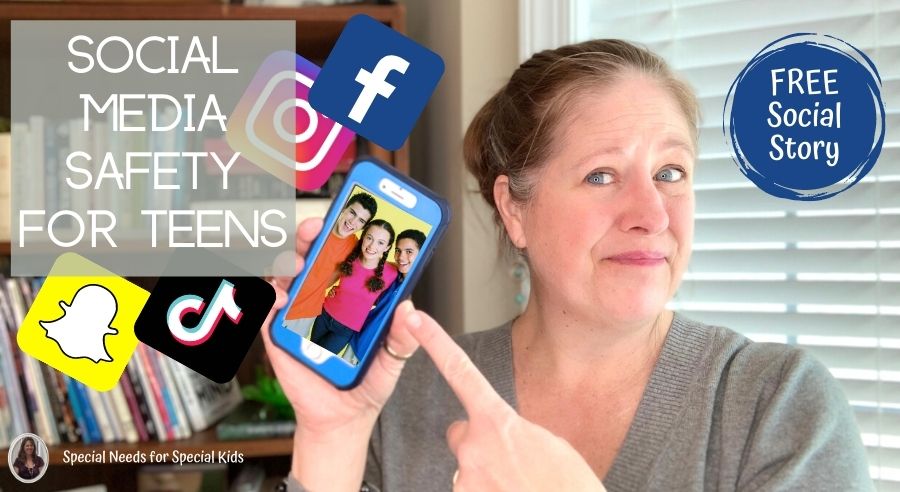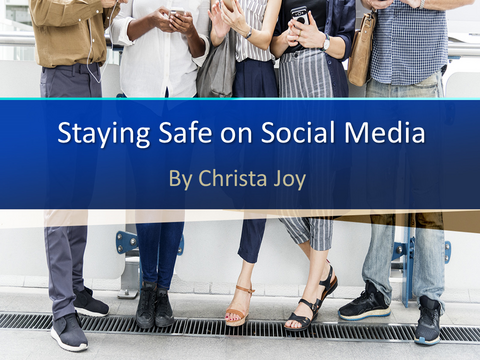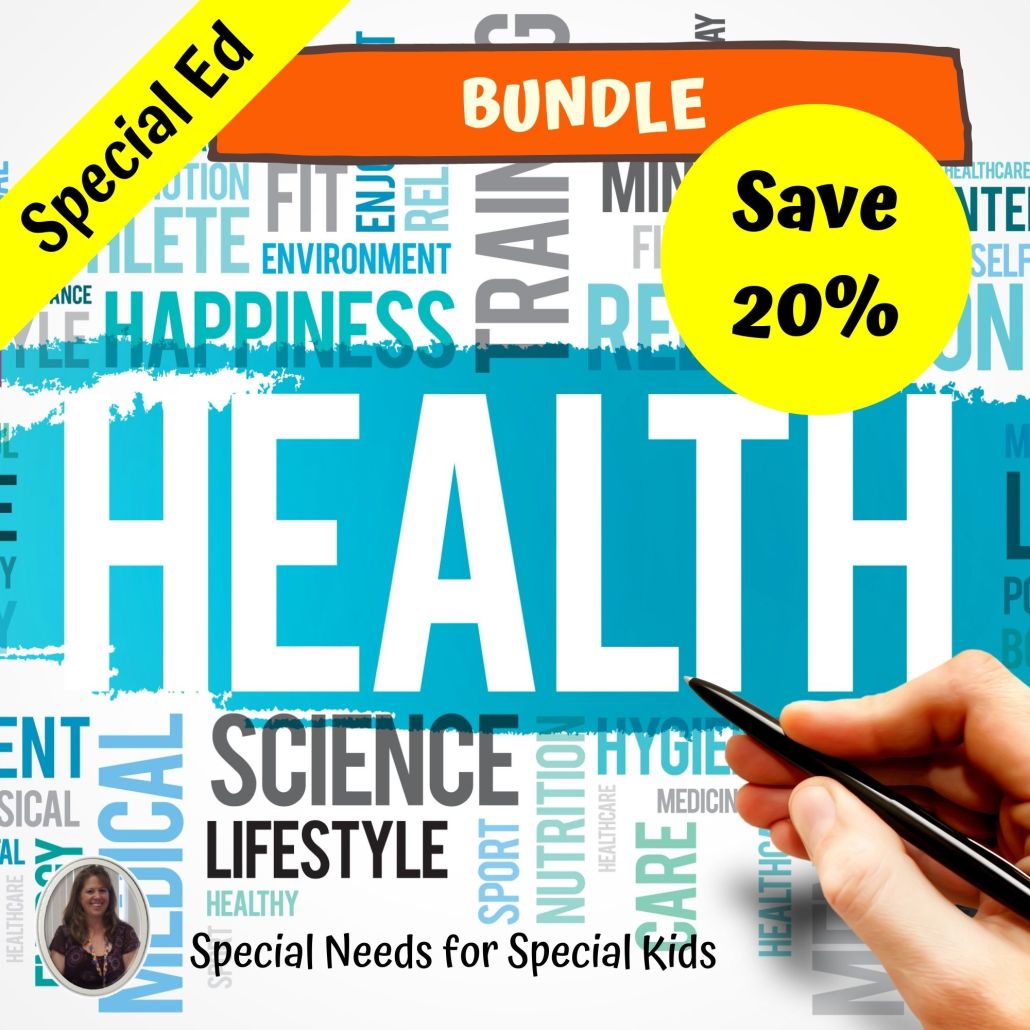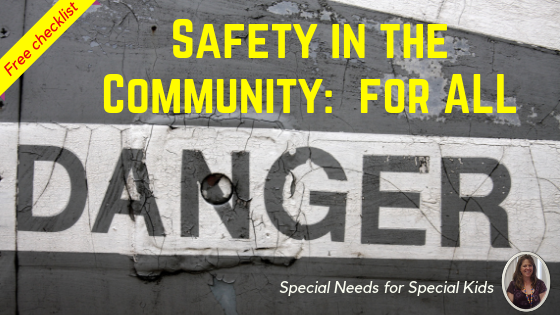Social media safety for teens is a tough subject. Finding materials for teaching social media are hard to come by. There are even fewer (if any) for students who have any kind of disability. But, there is a lot we can do at home and in the classroom when it comes to teaching social media to our kids. Here are some strategies and things to remember specifically if you work in a special education setting.
Improving social health
As we think about raising strong, healthy, confident kids we have to consider social health. Creating strong social connections is a big part of having kids who are socially healthy. In elementary school, we teach students how to build friendships, be a good sport and how to know if someone is being a bully. But as kids get older, their ability to connect with others becomes more diverse and less easy to monitor.
Students with disabilities often find themselves socially isolated. This is true for any number of reasons. Many of our students are busy with extra therapies and skill building groups. Sometimes finding time to just hang out with friends is hard to find.
Families are often overwhelmed just caring for their child’s needs. Parents are often stretched and working separately to accommodate the often complex needs our students face on a daily basis. Finding time for a play-date can be tough. Also, as kids get older, it can be more challenging to find peers willing to accept someone’s differences and welcome them fully into a social circle.
Finally, social isolation is often a choice the student makes for themself. Perhaps there have been years of negative peer interactions. Or, the student does not see or understand the value of close friendships.
Regardless of the cause, social media can be a great way to build social health and personal connections. But, the same dangers any normal teen faces when on a social media platform, will also be there for our kids as well. So, we need a way to teach them in a clear way how to be safe when using social media. Because in all likelihood they will be using it at some point.
Learning good etiquette
It is so easy to forget there is someone on the other end of that message you are sending out into the cyber world. As our students become old enough to begin exploring various ways of connecting with others on social media, we need to emphasize how important good etiquette is.
One good way to do this is to have students role-play any email, post, or message they plan to send before they send it. If it feels awkward out loud, then it will be awkward to the person receiving it. Tone, punctuation, and even capitalization are all important things to consider when it comes to good manners online.
It is also helpful in the beginning to provide students with scripts they can easily change to fit their situation. Once they become comfortable using a specific framework, it will be easier to modify it to make it more their own. And, if they choose to continue to use your script, then at least you know they will be safe and respectful.
Try coming up with several scripts that you think your students will use on a frequent basis. Craft them together and put each one on an index card. Clip the cards together or keep them in a box for quick reference.
What to share and not share on line
Now that we know social media can be important for social health, and we have addressed being kind and respectful, it is time to move on to the safety issue. Knowing what information you should never share is critical when talkking about social media safety for teens.
Some things will be obvious. Never share your address or phone number with someone on social media. First, you can never be sure the person is who they say they are, and second, there is a good chance many other people will see this information as well.
Other things like your favorite movie, sports team, or dessert seem less invasive and safer. A good test is to have students pretend they are talking to a total stranger. Would it be okay to share that information with someone you were standing right in front of but never met before?
Together, come up with a list of personal information that you would never want to share. Remember, some things seem innocuous like vacation plans, but can be very unsafe. Here are some things you want to make sure your kids know they should never share:
- Full name
- Phone number
- Address
- Age
- Parents’ names
- Parents’ work schedules
- School you go to
- Details about your daily schedule
- Any password
- Vacation plans
- Things you are afraid of
- Friends’ names or other information
- Any details that would make it easy to identify where you live
Never agree to meet in person
This, surprisingly, can be where social media for teens gets forgotten. Teenagers like to “meet up” and be in groups. Unless you know this person already as a friend in real life, you should never agree to meet someone you are talking with online. This includes going to a public place.
Students with disabilities may feel their home is a safe place, and that it would be okay to have someone meet them there. There is this false sense of security when it comes to the place you live. Do not assume students would never invite someone over to their home. Even if their parents are home, it should be clear that you never invite a person you do not know to your home.
Again, coming up with a list of people it is okay to meet with can be helpful. Each student can have their own list of people they already know and could invite over or agree to meet in a public place.
Don’t compare yourself to others
This can be a sneaky danger of social media. Social media safety for teens includes mental health. We have all gotten caught up in those perfect Instagram posts or TikTok videos. Even as adults, we can be fooled into thinking what we see on social media is not only true, but the whole picture. Our students can easily fall into the same trap.
Find some of those “perfect posts” and talk about them with your students. What do they see? What stories do they come up with about that person in that situation? How does it make them feel? For some students, empathy and realizing others think and feel differently than they do will find no danger in these types of posts at all. They simply do not even know how to compare themselves to others.
But, there will be those students who measure their value based on what they see in others. These are the students who are constantly copying what others are doing without even knowing why. They will pick the same foods at lunch, watch the same videos on YouTube, even start dressing the way others do. These are the students for whom social media comparisons can be so damaging.
Again, talking about various “perfect posts” of people none of you know can be a great exercise for dispelling these myths.
Social media safety for teens is an important issue that we need to address directly in the classroom and at home. It should be part of every health curriculum. I have a social story you can download here to get you started. Just click the button below.
If you are looking for more resources on health, including physical, mental and social health then check out my Health Bundle. It covers all three of these main areas with lots of activities perfect for students in a special education setting in middle or high school
To check out my Health Bundle click here
I also have a blog post of safety in the community. CLICK HERE to read more.
Finally, there are some good resources available online dealing with social media safety for teens. They do not necessarily apply to teens with disabilities, but these have some great information to share with parents.
- A Teen’s Guide to Social Media Safety
- Tips for Safe Social Networking for Teens
- Teens Ask: What is social media safety? (YouTube video)




